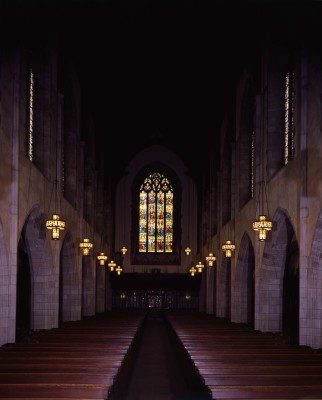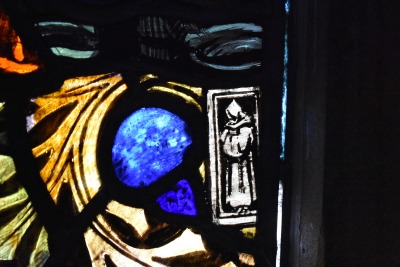A recent research inquiry made me curious about the Great West Window, also known as the Women’s Window, at Christ Church Cranbrook.
Bloomfield Hills was sparsely settled when the church was built and, reporting on his visit to Cranbrook in July 1924, the architect Oscar H. Murray speaks of George Gough Booth’s intention to build a community church and school “to form the core around which this new district shall develop”.
The church was a gift to the Bloomfield Hills community from George and Ellen Booth, their five children and their families, all of whom donated to its construction and fabric. The local history of settlement in Bloomfield extends some hundred years before the building of Christ Church Cranbrook; yet its flourishing as a community for families and as a center of cultural activity begins with the church, the first of the original group of Cranbrook institutions. All the artworks at the church are beautiful and unique, but to me, none more so than the Women’s Window.

View of the Great West Window, Christ Church Cranbrook. Jack Kausch, photographer. Copyright Cranbrook Archives
The Women’s Window is the gift of James Alfred Beresford and Florence Booth Beresford. It was designed by James H. Hogan and fabricated by James Powell and Sons, (Whitefriars) Ltd, then based in Wealdstone, London, England. Established in 1680, their insignia is a whitefriar monk wearing a white cowl. Their original location on Fleet Street was in the Whitefriar district where a Carmelite order had once resided. The insignia is included in the Women’s Window, but at just a few inches high, it is impossible to see from the church floor.

The whitefriar insignia of James Powell and Sons (Whitefriars), Ltd on Panel 16 of the Women’s Window of Christ Church Cranbrook. Kevin Adkisson, photographer. Copyright Cranbrook Archives.
The key component of stained glass is silica from river sand. Modern stained glass is made of sand, lime, and soda and is more durable than the stained glass of the middle ages, which used ash instead of lime, making it more susceptible to the elements.
“The coloured glasses used in the making of the window are all the product of the Whitefriars works, in fact what comes to us in the form of sand, leaves us as a work of art in the form of a Stained Glass Window.” Adrian A. Buck, October 31st, 1927 (1981-01 20:9)
The glass pieces are fitted into cames—H or I shaped lead fixtures—which are then soldered together at the ends to form the design, and the whole window is supported by larger T bars and saddle bars. The Women’s Window stands 19 ½ feet tall and 8 feet wide.
As with most of the windows at Christ Church Cranbrook, the Women’s Window is made of antique glass—this does not refer to the age of the glass, but rather to its method of manufacture. It is hand-made glass using the traditional medieval method of glass blowing, giving it an irregular surface that adds to the effect of jewel tones. Other types of stained glass (cathedral and opalescent) are machine made and do not convey the same vibrancy of antique glass.
The Window’s aesthetic style is Gothic Revival and its coloring is thought to suggest the pre-Raphaelite influence of William Morris and Edward Burne-Jones, with whom Powell was acquainted and with whom George Booth found deep inspiration and kinship.
It features 60 women within 16 panels arranged in 4 tiers. Each panel depicts an area of contribution to sacred and secular life, including motherhood, Christ’s associates, early missionaries, early saints, religious orders, American church missionaries, educators, nurses, musicians, artists, poets, novelists, sovereigns, liberators, suffrage workers, and actresses. These panels are mediated by 6 smaller panels, each depicting two angels with shields portraying the fiery cross, the word of God, the mirror of truth, the flame of inspiration, the regal crown, and tragedy/comedy.

Panel 1, Motherhood: Hannah, mother of Samuel; Monica, mother of St. Augustine; the Virgin Mary; Elizabeth with her son, John the Baptist. Tom Booth, photographer. Copyright Christ Church Cranbrook 2010.

Panel 2, Christ’s Associates: Mary, mother of James the Apostle; Mary, mother of Mark the evangelist; Mary Magdalene; Martha, sister of Lazarus; the poor woman who put her mite in the Temple treasury. Tom Booth, photographer. Copyright Christ Church Cranbrook 2010.

Panel 3, Early Missionaries: Pricilla, who helped Paul in Greece; Lydia, who housed him in Galatia; Phoebe, who helped many including Paul at Cenchrea; Dorcas, a benevolent woman of Joppa whom Paul raised from the dead. Tom Booth, photographer. Copyright Christ Church Cranbrook 2010.

Panel 4, Early Saints: Perpetua and Felicitas, both martyred at Carthage, A.D. 202; Agnes, martyred at Rome, ca. 304. Tom Booth, photographer. Copyright Christ Church Cranbrook 2010.

Panel 5, Active in Religious Orders: Teresa(Spanish, 1515-82), founder of the Teresians or Barefooted Carmelites; Catherine of Siena (Italian, 1347-80), a member of the third (lower) order of Dominicans who tended the needy; Hilda (English, 614-82), founder and Abbess of Whitby, famous for her wisdom; Clare, who founded the Poor Clares of Assisi in the XIIIth century. Tom Booth, photographer. Copyright Christ Church Cranbrook 2010.

Panel 6, American Church Missionaries: Mary S. Francis (1847-1937), who worked in South Dakota for 30 years; Julia C. Emery (1876-1916), secretary to the Woman’s Auxiliary of the Board of Missions; Deaconess Bertha Sabine (1844-1931), missionary in Alaska; Anne C. Farthing (1862-1910) of the Alaskan field. Tom Booth, photographer. Copyright Christ Church Cranbrook 2010.

Panel 7, Educators: Maria Mitchell (1818-89), astronomer and Vassar professor; Alice Freeman Palmer (1855-1902), President of Wellesley College; Mary Lyon (1797-1849), who founded Mount Holyoke College in 1836. Tom Booth, photographer. Copyright Christ Church Cranbrook 2010.

Panel 8, Nurses: Dr. Mary E. Glenton (1862-1923), missionary to Alaska, China, and to the African Americans of North Carolina; Florence Nightingale (English, 1820-1910), philanthropist and founder of scientific nursing; Clara Barton (1821-1912), President of the American Red Cross 1881-1904; Edith Louisa Cavell (English, 1872-1915), founder of a Belgian nursing school, who was executed for helping prisoners escape during World War I. Tom Booth, photographer. Copyright Christ Church Cranbrook 2010.

Panel 9, Musicians: Liza Lehman (English, 1862-1918); St. Cecilia, a patron of music, martyred in Sicily, ca. 176; Cecile Chaminade (French, 1857-1944), composer and pianist. Tom Booth, photographer. Copyright Christ Church Cranbrook 2010.

Panel 10, Artists: Vigee Lebrun (French, 1755-1842), painter of portraits; Rosa Bonheur (French, 1822-99), painter of animals; Mary Cassatt (American, 1855-1926), impressionist painter and pastellist; Maria Ann Kaufman, called Angelica (English, 1741-1807). Tom Booth, photographer. Copyright Christ Church Cranbrook.

Panel 11, Poets: Amy Lowell (American, 1874-1925); Elizabeth Barret Browning (English, 1806-61); Emily Dickinson (American, 1830-86); Christina Georgina Rosetti (English, 1830-94); Emily Jane Bronte (English, 1818-48). Tom Booth, photographer. Copyright Christ Church Cranbrook 2010.

Panel 12, Novelists: Jane Austen (English, 1755-1817); Mary Ann Evans Cross, called George Eliot (English, 1819-80); Charlotte Bronte (English, 1816-55); Louisa May Alcott (American, 1832-88). Tom Booth, photographer. Copyright Christ Church Cranbrook 2010.

Panel 13, Sovereigns: Queen Elizabeth I (English, 1533-1603); Isabella (Spanish, 1451-1504) with Columbus whom she helped; Victoria (English, 1819-80). Tom Booth, photographer. Copyright Christ Church Cranbrook 2010.

Panel 14, Liberators: Lucretia Coffin Mott (American, 1793-1880), active against slavery and for women’s rights; Jeanne d’Arc (French, 1412-31), mystic, military leader and martyr; Harriet Beecher Stowe (American, 1811-96), with slave boy, who greatly influenced the emancipation of African Americans through “Uncle Tom’s Cabin”. Tom Booth, photographer. Copyright Christ Church Cranbrook 2010.

Panel 15, Suffrage Workers: Dolly Madison (1768-1849); Susan Brownell Anthony (American, 1820-1906); Anna Howard Shaw (English-American, 1847-1919); Elizabeth Cady Stanton (American, 1815-1902), who with Lucretia Mott called the first suffrage convention. Tom Booth, photographer. Copyright Christ Church Cranbrook 2010.

Panel 16, Actresses: Sarah Siddons (English, 1755-1831); Sarah Bernhardt (French, 1845-1923); Mary Anderson (American, 1859-1940); Ellen Terry (English, 1848-1928). Tom Booth, photographer. Copyright Christ Church Cranbrook 2010.
The women were selected from across history, from biblical times to 1920s, by the Rev. Samuel S. Marquis, the first rector of the church. Inscribed at the base of the window is the verse, “Her children rise up and call her blessed, and her works praise her in the gates” (Proverbs 31:28, 31).
The window has long been beloved by members and visitors to Christ Church. It was also the featured window of the Michigan Stained Glass Census in June 1998. The Women’s Window underwent restoration in 2004-2005 by Thompson Art Glass to celebrate the 75th anniversary of the church. Speaking at the time of its completed restoration, the Rev. Edward L. Mullins remarked that, “when the light shines through it, we see a wonderful picture of the world”.
– Laura MacNewman, Associate Archivist

















